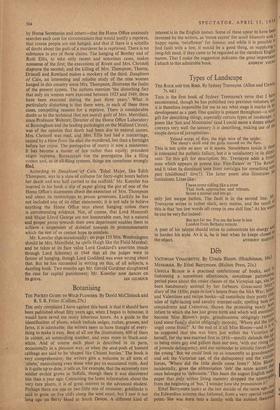Types of Landscape
THIS is the first book of Sydney Tremayne's verse that I hal encountered, though he has published two previous volumes, and it is therefore impossible for me to say what stage it marks in h,'! development as a poet. One quality is present throughout—a vivo gift for describing things, especially certain types of landscape. poem like `Sun and Mountains' (and I could name a dozen others) conveys very well the scenery it is describing, making use of the simple device of juxtaposition :
Veined wings of flies, the high wire of the spider, The sheep's skull and the gulls massed on the flats.
This is not quite so easy as it seems. Somewhere inside it there is concealed the pathetic fallacy, but it is satisfactory in its direeli ness. To this gift for description Mr. Tremayne adds a lyeic3, note which appears in poems like, 'Fire-Eaters' or 'The Reeve and it takes its dominant tone from nostalgia for something 11° past (childhood? love?). The latter poem also illustrates bi5 limitations. Lines like :
I have come sidling like a crow That both approaches and retreats, Seizes a morsel and lets go
only just escape bathos. The fault is in the second line. Mr' i Tremayne writes in rather slack, easy metres, and the result this is that `ten low words oft creep in one dull line.' At his mor5 he can be very flat indeed :
But not for me. For me the hour is late London from Bethany remote. nd A poet of his talents should strive to concentrate his energy - a „ to harden his style. As it is, he is best when he keeps closest










































 Previous page
Previous page